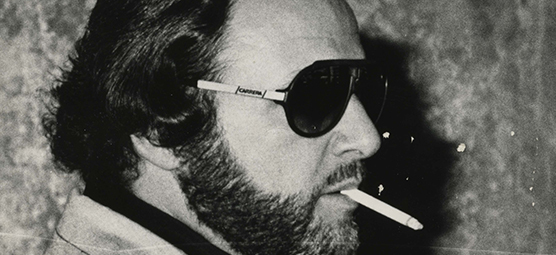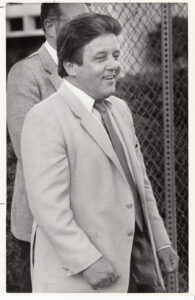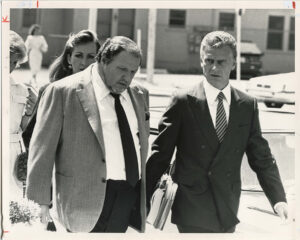A late Mob hit in Las Vegas
‘Fat Herbie’ Blitzstein was murdered 20 years ago this month

First of two parts. Part Two looks at Blitzstein’s criminal activity in Las Vegas.

By the mid-1990s, death had claimed nearly all the famous Italian and Jewish bosses of America’s traditional organized crime families. But in Los Angeles there still existed vestiges of Mob days gone by, a group of inept hoods nicknamed the “Mickey Mouse Mafia.” Their desire to control relatively small street rackets in Las Vegas led to a gangland execution years after the Mob had lost its grip on the gambling capital.
The victim of the hit was Herbert “Fat Herbie” Blitzstein, a 62-year-old former Chicago bookmaker and one-time right-hand man to the late Tony Spilotro, the Chicago Outfit’s local crime director in Las Vegas until his murder in 1986. Blitzstein ran a lucrative loansharking racket coveted by jealous low-level representatives of the Los Angeles and Buffalo syndicates working in Las Vegas.
After Blitzstein’s murder, the FBI’s ongoing organized crime investigation intensified, resulting in a 50-count federal indictment and some defendants flipping on each other for reduced sentences.
On the night of January 6, 1997 – 20 years ago this month — Blitzstein had just returned to his eastern Las Vegas townhome to find two armed men waiting. Earlier in the day, Los Angeles Mob associate and expert burglar Peter Vincent Caruso had gained access to the home thanks to Blitzstein’s partner in auto insurance fraud, Joe DeLuca. Caruso reportedly stole $50,000 of Blitzstein’s cash, plus jewelry and coins. Caruso then left the door open for the gunmen.
One of the hitmen, either Richard Friedman or Antone Davi, pulled the trigger of a small-caliber handgun aimed at Blitzstein, who purportedly put his hands to his face and asked “Why me?” before dropping dead from a head wound. He slumped face first onto a leather easy chair. Friedman and Davi rifled through Blitzstein’s pockets before leaving. They were paid the cut-rate sum of $3,500 for the hit. Later, during proceedings in federal court, each would blame the other for firing the fatal shot.
The Sea Breeze social club
Blitzstein’s murder came as the FBI was conducting an undercover investigation into organized crime activities in Las Vegas that had begun in the fall of 1994. During the probe, known as “Operation Thin Crust,” the FBI set up a social club to entice local mobsters to meet. The club’s operator was Anthony Angioletti, a 37-year-old ex-con tied to the Genovese crime family in New York who turned informant for the FBI while in Los Angeles. Angioletti leased a single-room space in an office park near the Rio hotel-casino about a mile west of the Las Vegas Strip. The social club, called the “Sea Breeze,” had a refrigerator and stove that Angioletti used to prepare Italian food. The place quickly became popular among local gangsters and the ideal spot for agents to observe and listen in on conversations about plans for future crimes.
The agents overheard discussions among club patrons about burglarizing the homes of wealthy people, passing counterfeit traveler’s checks, taking over local escort services and various other criminal scams.
“It was a place where people would come in, sit down and talk,” John Plunkett, who oversaw Operation Thin Crust with the FBI’s Organized Crime Squad in Las Vegas, told the Las Vegas Sun in 2002. “Angioletti was a loud guy. People didn’t like him, but he was a great cook and it was a free meal to most of those guys.”
Michael Howey, the case agent for the FBI during Operation Thin Crust, told the Sun that at first he thought the social club idea “was kind of a pipe dream. But lo and behold, two days after it opened the who’s who of LCN [La Cosa Nostra] guys in Las Vegas were there.”
L.A. mobsters

Another agent who worked undercover amid the socializers at the Sea Breeze was Charles Maurer, imported from the FBI’s Pittsburgh office. “This is how LCN people spend their day,” Maurer said in the Sun story. “Their lifestyles are a lot different from ours. They get up in the morning. They don’t go to work. They go to the club, and they talk about old stories.”
Blitzstein soon frequented the Sea Breeze with his friend and longtime Mob associate John Branco, with whom he did time in a federal prison in California in the late ’80s. Branco, who had been convicted of multiple counts of possessing counterfeit money, was a tough, revered Mob soldier from Los Angeles. Both men were nearly the same age: Blitzstein 61 and Branco 60.
The FBI also focused on two members of the Los Angeles Mob who liked to preen at the Sea Breeze. One was Peter Vincent Caruso, described by authorities as a “one-man crime wave,” so obsessive about committing crimes that he once boasted of successfully stealing a safe from a house while suffering a heart attack. Another was L.A. capo Louis Caruso (no relation to Peter), who worked Las Vegas under the direction of L.A. boss Peter Milano and his brother, underboss Carmine Milano.
Within months after the Sea Breeze opened in 1996, Branco took the lead in proposing crimes, such as burglarizing the homes of Becky Behnen (the wealthy sister of Blitzstein’s friend and Horseshoe casino executive Ted Binion) and a nightclub owner in Beverly Hills, California. Neither plot was carried out but Branco did succeed, with Peter Caruso, in strong-arming a Las Vegas escort service owner into paying them $5,000 for “protection” twice a year.
The FBI’s social club gambit went so well that conversations intercepted from legal wiretaps revealed that Louis Caruso, who owned some legitimate businesses in L.A., wanted to come to Las Vegas to see how he could make extra money.
Louis Caruso was a stickler for customary Mafia protocol of loyalty and respect for Mob hierarchy. His arrival in Las Vegas in 1996 was a fateful step toward what would happen to Blitzstein about six months later.
Blitzstein’s booth

A favorite hangout for Las Vegas Mob types such as Blitzstein was Club Paradise, the topless bar on Paradise Road across from the Hard Rock hotel-casino. Blitzstein spent so much time in the place that he laid claim to a specific booth. Sometime in May 1996, Blitzstein walked in at night and Louis Caruso, whether by design or accident, was sitting in that booth with some L.A. Mob cronies. Blitzstein, not knowing Caruso by sight, had the club’s bouncers force Caruso and company to sit elsewhere. The group, incensed, glared at Blitzstein. When Branco entered the club later, Blitzstein complained about the “assholes” staring him down. Branco then recognized his associate Louis.
Realizing Louis would be offended by the disrespect, Branco attempted to excuse Blitzstein, but Caruso took the matter to L.A. boss Peter Milano. It prompted a Mob sit-down in the City of Angels in June, attended by Branco, Louis Caruso and Branco’s friend Vincent “Jimmy” Caci, an L.A. capo assigned to act as arbitrator. Branco explained to Caruso that he should not expect any kind of mea culpa from Blitzstein. Then it was time for Caruso to lose some face yet again. Caci noticed two Hells Angels bikers whom Caruso hired for protection and flew into a rage about bringing non-family members into the dispute. It was fatal to Caruso’s standing at the Mob meeting, and for that break in the code of behavior, the decision went in Branco’s favor. Nothing, it now seemed, would happen to Blitzstein for the slight.
But Caruso still thought he had a score to settle. He started thinking about eliminating Blitzstein and taking over his Las Vegas rackets.
Suspect turns informant
Branco soon had a day of reckoning of sorts himself, courtesy of his own hubris, and the FBI. Undercover agent Maurer had successfully penetrated the Sea Breeze to secretly gather evidence based on information from FBI phone taps. In the process Maurer befriended the unsuspecting Branco. In July, Las Vegas police arrested Branco in connection with an outcall dance service owner who claimed he was kidnapped, roughed up and pressured to pay for protection. Branco, an ex-felon looking at a lengthy stretch in prison, decided to turn informant for the FBI’s drive to nab the L.A. Mob in Las Vegas.
“I said, ‘I don’t want this,’” Branco said in a quote published in the Sun. “I don’t want to go back to that damn pen. I don’t want my wife to go through what she had to do, starving to death, while I’m pulling time.”
The FBI had to walk a tightrope with Branco to preserve the integrity of Operation Thin Crust. Agents coached and prepared him to work for them at the Sea Breeze and inside the rest of the Las Vegas Mob scene. However, agents were careful not to reveal to either Branco or Angioletti that Maurer was working undercover. They also made sure Branco and Angioletti did not know the other was an informant. Soon, agents lost trust in what Angioletti told them, but regarded Branco as reliable. After he informed them that October of a plot by members of the Los Angeles and Buffalo mobs to steal Blitzstein’s loansharking and other rackets, they decided it was time to tell him about Maurer.
Meanwhile, the FBI kept Blitzstein under visual surveillance. Agents would insist they did not know about any plan to kill him, even though they had his home under surveillance when the gunmen arrived. Branco did learn of, and told the FBI about, a planned hit on Blitzstein. But Branco told his Mob friends he opposed it and thought they had agreed with him. He spoke to Louis Caruso, who told him it would not be carried out. But Caruso lied.
On January 7, the morning after the shooting, DeLuca gained entry to Blitzstein’s home, confirmed Blitzstein’s death and contacted the authorities. His cover story was that it was not like Blitzstein to fail to show up for a meeting at their car mechanic business, Any Auto Repair on Fremont Street. DeLuca and Blitzstein used the shop as a front while fabricating auto accident insurance claims. DeLuca, a small-time hood, would be central to what happened to Blitzstein and eventually the downfall of the members of the Los Angeles and Buffalo organized crime families who had ventured into Las Vegas.
Images courtesy of the Las Vegas Review-Journal
Feedback or questions? Email blog@themobmuseum.org





